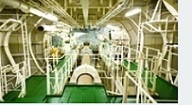
R717 Ammonia as Marine Refrigerant
The ammonia used for refrigeration systems based on the use of a compressor,
condenser, expansion valve and an evaporator is dry (anhydrous)
in that there is no water in solution with it. It has the chemical formula NH3 but
as a refrigerant, it is coded with the number R717.
The good qualities of ammonia as a refrigerant have been offset by its toxicity, flammability and pungent odour, so that carbon dioxide and then CFCs (which replaced CO2) were used at sea in preference. Now that R12 is to be phased out in the short term and R22 at a later date, ammonia is being considered as a replacement, because despite its local harmful effects and disadvantages, it is ozone friendly.
The good qualities of ammonia as a refrigerant have been offset by its toxicity, flammability and pungent odour, so that carbon dioxide and then CFCs (which replaced CO2) were used at sea in preference. Now that R12 is to be phased out in the short term and R22 at a later date, ammonia is being considered as a replacement, because despite its local harmful effects and disadvantages, it is ozone friendly.

